Parachuting
This article needs additional citations for verification. (September 2009) |

Parachuting, also known as skydiving, is the action of exiting an aircraft and returning to earth with the aid of gravity while using a parachute to slow down during the final part of the descent. It may or may not involve a certain amount of free-fall, a time during which the parachute has not been deployed and the body gradually accelerates to terminal velocity.
The history of skydiving starts with Andre-Jacques Garnerin who made successful parachute jumps from a hot-air balloon in 1797. The military developed parachuting technology as a way to save aircrews from emergencies aboard balloons and aircraft in flight, later as a way of delivering soldiers to the battlefield. Early competitions date back to the 1930s, and it became an international sport in 1952.
Parachuting is performed as a recreational activity and a competitive sport, as well as for the deployment of military personnel Airborne forces and occasionally forest firefighters.
A skydiving center can be a commercial operation or a club, usually operates at an airport, and provides one or more aircraft that takes groups of skydivers up for a fee. An individual jumper can go up in a light aircraft such as a Cessna C-172 or C-182. In busier drop zones (DZ) larger aircraft may be used such as the Cessna Caravan 208, de Havilland Canada DHC-6 Twin Otter, Airvan or Short Skyvan.
A typical jump involves individuals exiting an aircraft (usually an airplane, but sometimes a helicopter or even the gondola of a balloon), at anywhere from 1,000 to 4,000 meters (3,000 to 13,000 feet) altitude. If jumping from a low altitude, the parachute is deployed immediately; however, at higher altitudes, the skydiver may free-fall for a short period of time (about a minute)[1] before activating a parachute to slow the landing down to safe speeds (about 5 to 7 minutes).
When the parachute opens (usually the parachute will be fully inflated by 800 meters or 2,600 feet) the jumper can control the direction and speed with toggles on the end of steering lines attached to the trailing edge of the parachute, and can aim for the landing site and come to a relatively gentle stop. All modern sport parachutes are self-inflating "ram-air" wings that provide control of speed and direction similar to the related paragliders. Purists in either sport would note that paragliders have much greater lift and range, but that parachutes are designed to absorb the stresses of deployment at terminal velocity.
By manipulating the shape of the body in freefall, a skydiver can generate turns, forward motion, backwards motion, and even lift.
When leaving an aircraft, for a few seconds a skydiver continues to travel forward as well as down, due to the momentum created by the plane's speed (known as "forward throw"). The perception of a change from horizontal to vertical flight is known as the "relative wind", or informally as "being on the hill". In freefall, skydivers generally do not experience a "falling" sensation because the resistance of the air to their body at speeds above about 50 mph (80 km/h) provides some feeling of weight and direction. At normal exit speeds for aircraft (approx 90 mph (140 km/h)) there is little feeling of falling just after exit, but jumping from a balloon or helicopter can create this sensation. Skydivers reach terminal velocity (around 120 mph (190 km/h) for belly to Earth orientations, 150–200 mph (240–320 km/h) for head down orientations) and are no longer accelerating towards the ground. At this point the sensation is as of a forceful wind.
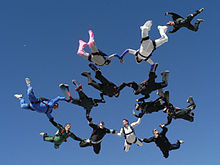
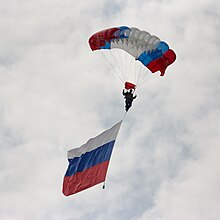
Many people make their first jump with an experienced and trained instructor – this type of skydive may be in the form of a tandem skydive. During the tandem jump the instructor is responsible for emergency procedures in the unlikely event that they will be needed, therefore freeing the student to concentrate on learning to skydive. Other training methods include static line, IAD (Instructor Assisted Deployment), and AFF (Accelerated Free fall) also known as Progressive Free-Fall (PFF) in Canada.
Safety
Despite the perception of danger, fatalities are rare. However, each year a number of people are hurt or killed parachuting worldwide.[2][3] About 21 skydivers are killed each year in the US, roughly one death for every 150,000 jumps (about 0.0007%).[4][5]
In the US and in most of the western world skydivers are required to carry two parachutes. The reserve parachute must be periodically inspected and re-packed (whether used or not) by a certificated parachute rigger (in the US, an FAA certificated parachute rigger). Many skydivers use an automatic activation device (AAD) that opens the reserve parachute at a pre determined altitude if it detects the skydiver is still in free fall. Most skydivers wear a visual altimeter, and an increasing number also use audible altimeters fitted to their helmet.
Injuries and fatalities occurring under a fully functional parachute usually happen because the skydiver performed unsafe maneuvers or made an error in judgment while flying their canopy, typically resulting in a high speed impact with the ground or other hazards on the ground.[6] One of the most common sources of injury is a low turn under a high-performance canopy and while swooping. Swooping is the advanced discipline of gliding parallel to the ground during landing.

Changing wind conditions are another risk factor. In conditions of strong winds, and turbulence during hot days the parachutist can be caught in downdrafts close to the ground. Shifting winds can cause a crosswind or downwind landing which have a higher high potential for injury due to the wind speed adding to the landing speed.
Another risk factor is that of "canopy collisions", or collisions between two or more skydivers under fully inflated parachutes. Canopy collisions can cause the jumpers' inflated parachutes to entangle with each other, often resulting in a sudden collapse (deflation) of one or more of the involved parachutes. When this occurs, the jumpers often must quickly perform emergency procedures (if there is sufficient altitude to do so) to "cut-away" (jettison) from their main canopies and deploy their reserve canopies. Canopy collisions are particularly dangerous when occurring at altitudes too low to allow the jumpers adequate time to safely jettison their main parachutes and fully deploy their reserve parachutes.
Equipment failure rarely causes fatalities and injuries. Approximately one in 750 deployments of a main parachute results in a malfunction.[7] Ram-air parachutes typically spin uncontrollably when malfunctioned, and must be jettisoned before deploying the reserve parachute. Reserve parachutes are packed and deployed differently; they are also designed more conservatively and built and tested to more exacting standards so they are more reliable than main parachutes, but the real safety advantage comes from the probability of an unlikely main malfunction multiplied by the even less likely probability of a reserve malfunction. This yields an even smaller probability of a double malfunction although the possibility of a main malfunction that cannot be cutaway causing a reserve malfunction is a very real risk.
Parachuting disciplines such as BASE jumping or those that involve equipment such as wing suit flying and sky surfing have a higher risk factor due to the lower mobility of the jumper and the greater risk of entanglement. For this reason these disciplines are generally practised by experienced jumpers.
Depictions in commercial films – notably Hollywood action movies – usually overstate the dangers of the sport. Often, the characters in such films are shown performing feats that are physically impossible without special effects assistance. In other cases, their practices would cause them to be grounded or shunned at any safety-conscious drop zone or club. USPA member drop zones in the US and Canada are required to have an experienced jumper act as a "safety officer" (in Canada DSO – Drop Zone Safety Officer; in the U.S. S&TA – Safety and Training Advisor) who is responsible for dealing with the jumpers who violate rules, regulations, or otherwise act in a fashion deemed unsafe by the appointed individual.
In many countries, either the local regulations or the liability-conscious prudence of the dropzone owners require that parachutists must have attained the age of majority before engaging in the sport.
Weather
Parachuting in poor weather, especially with thunderstorms, high winds, and dust devils can be a dangerous activity. Reputable drop zones will suspend normal operations during inclement weather.
Canopy Collisions
A collision with another canopy is a statistical hazard, and may be avoided by observing simple principles.
Training
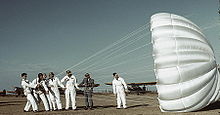
Skydiving can be practised without jumping. Vertical wind tunnels are used to practise for free fall ("indoor skydiving" or "bodyflight"), while virtual reality parachute simulators are used to practise parachute control.
Beginning skydivers seeking training have the following options:
Parachute deployment
At a skydiver's deployment altitude, the individual manually deploys a small pilot-chute which acts as a drogue, catching air and pulling out the main parachute or the main canopy. There are two principal systems in use : the "throw-out", where the skydiver pulls a toggle attached to the top of the pilot-chute stowed in a small pocket outside the main container : and the "pull-out", where the skydiver pulls a small pad attached to the pilot-chute which is stowed inside the container.
Throw-out pilot-chute pouches are usually positioned at the bottom of the container – the B.O.C. deployment system – but older harnesses often have leg-mounted pouches. The latter are safe for flat-flying, but often unsuitable for freestyle or head-down flying.
In a typical non-military parachute system, such as the throw-out, the pilot-chute is connected to a line known as the "bridle", which is in turn attached to a small deployment bag that contains the folded parachute, with the suspension lines stowed in rubber bands. At the bottom of the container that holds the deployment bag is a closing loop which, during packing, is fed through the grommets of the four flaps that are used to close the container. At that point, a curved pin that is attached to the bridle is inserted through the closing loop. The next step involves folding the pilot-chute and placing it in a pouch (e.g. B.O.C pouch).
Activation begins when the pilot chute is thrown out. It inflates and creates drag, pulling the pin out of the closing loop and allowing the pilot-chute to pull the deployment bag from the container. The parachute lines are pulled loose from the rubber bands and extend as the canopy starts to open. A rectangular piece of fabric called the "slider" (which separates the parachute lines into four main groups fed through grommets in the four respective corners of the slider) slows the opening of the parachute and works its way down until the canopy is fully open and the slider is just above the head of the skydiver. The slider slows and controls the deployment of the parachute. Without a slider, the parachute would inflate fast, potentially damaging the parachute fabric and/or suspension lines. During a normal deployment, a skydiver will generally experience a few seconds of intense deceleration, in the realm of 3 to 4 G, while the parachute slows the descent from 120 mph (190 km/h) to approximately 18 mph.
If a skydiver experiences a malfunction of their main parachute which they cannot correct, they pull a "cut-away" handle on the front right-hand side of their harness (on the chest) which will release the main canopy from the harness/container. Once free from the malfunctioning main canopy, the reserve canopy can be activated manually by pulling a second handle on the front left harness. Some containers are fitted with a connecting line from the main to reserve parachutes – known as a reserve static line (RSL) – which pulls opens the reserve container faster than a manual release could. Whichever method is used, a spring-loaded pilotchute then extracts the reserve parachute from the upper half of the container.
Variations
In addition to disciplines for which people train, purchase equipment and get coaching/lessons, the recreational skydiver finds ways to just have fun.
Hit and Rock
One example of this is "Hit and Rock", which is a variant of Accuracy landing devised to let people of varying skill levels compete for fun. "Hit and Rock" is originally from POPS (Parachutists Over Phorty Society). See the POPS main site. The object is to land as close as possible to the chair, remove the parachute harness, sprint to the chair, sit fully in the chair and rock back and forth at least one time. The contestant is timed from the moment that feet touch the ground until that first rock is completed. This event is considered a race.
Freeflying
Tracking
Tracking is where skydivers take a body position to achieve a high forward speed, flying their body to achieve separation from other jumpers and cover distance over the ground.
Formation skydiving
Pond swooping
Pond swooping is a form of competitive parachuting wherein canopy pilots attempt to touch down at a glide across a small body of water, and onto the shore. Events provide lighthearted competition, rating accuracy, speed, distance and style. Points and peer approval are reduced when a participant "chows", or fails to reach shore and sinks into the water. Swoop ponds are not deep enough to drown in under ordinary circumstances, their main danger being from the concussive force of an incorrectly executed maneuver. In order to gain distance, swoopers increase their speed by executing a "hook turn," wherein which both speed and difficulty increase with the angle of the turn. Hook turns are most commonly measured in increments of 90 degrees. As the angle of the turn increases, both horizontal and vertical speed are increased, such that a misjudgement of altitude or imprecise manipulation of the canopy's control structures (front risers, rear risers, and toggles) can lead to a high speed impact with the pond or Earth. Prevention of injury is the main reason why a pond is used for swooping rather than a grass landing area.
Cross-country
A cross-country jump is a skydive where the participants open their parachutes immediately after jumping, with the intention of covering as much ground under canopy as possible. Usual distance from Jump Run to the dropzone can be as much as several miles.
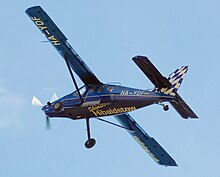
Camera flying
In camera flying, a camera person jumps with other skydivers and films them. The camera flier often wears specialized equipment, such as a winged jumpsuit to provide a greater range of fall rates, helmet-mounted video and still cameras, mouth operated camera switches, and optical sights. Some skydivers specialize in camera flying and a few earn fees for filming students on coached jumps or tandem-jumpers, or producing professional footage and photographs for the media.
There is always a demand for good camera fliers in the skydiving community, as many of the competitive skydiving disciplines are judged from a video record.
Night jumps
Parachuting is not always restricted to daytime hours; experienced skydivers sometimes perform night jumps. For safety reasons, this requires more equipment than a usual daytime jump and in most jurisdictions requires both an advanced skydiving license (at least a B-License in the U.S.) and a meeting with the local safety official covering who will be doing what on the load. A lighted altimeter (preferably accompanied with an audible altimeter) is a must. Skydivers performing night jumps often take flashlights up with them so that they can check their canopies have properly deployed.
Visibility to other skydivers and other aircraft is also a consideration; FAA regulations require skydivers jumping at night to be wearing a light visible for three miles (5 km) in every direction, and to turn it on once they are under canopy. A chemlight(glowstick) is a good idea on a night jump.
Night jumpers should be made aware of the Dark Zone, when landing at night. Above 100 feet jumpers flying their canopy have a good view of the landing zone normally because of reflected ambient light/moon light. Once they get close to the ground, this ambient light source is lost, because of the low angle of reflection. The lower they get, the darker the ground looks. At about 100 feet and below it may seem that they are landing in a black hole. Suddenly it becomes very dark, and the jumper hits the ground soon after. This ground rush should be explained and anticipated for the first time night jumper.
Stuff jumps
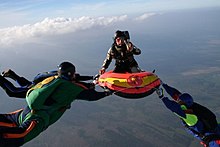
With the availability of a rear door aircraft and a large, unpopulated space to jump over, 'stuff' jumps become possible. In these jumps the skydivers jump out with some object. Rubber raft jumps are popular, where the jumpers sit in a rubber raft. Cars, bicycles, motorcycles, vacuum cleaners, water tanks and inflatable companions have also been thrown out the back of an aircraft. At a certain height the jumpers break off from the object and deploy their parachutes, leaving it to smash into the ground at terminal velocity.
Skysurfing
BASE jumping
Wingsuit flying
Organizations
National parachuting associations exist in many countries, many affiliated with the Fédération Aéronautique Internationale (FAI), to promote their sport. In most cases, national representative bodies, as well as local dropzone operators, require that participants carry certification, attesting to their training, their level of experience in the sport, and their proven competence. Anyone who cannot produce such bona-fides is treated as a student, requiring close supervision.
The primary organization in the United States is the United States Parachute Association (USPA)[1]. This organization awards licenses and ratings for all American skydiving activities based on safety qualifications. The USPA governs safety in the sport of skydiving as this is the organizations sole responsibility and also publishes the Skydivers Information Manual (SIM) and many other resources. In Canada, the Canadian Sport Parachuting Association is the lead organization. In South Africa the sport is managed by the Parachute Association of South Africa, and in the United Kingdom by the British Parachute Association.
Within the sport, associations promote safety, technical advances, training-and-certification, competition and other interests of their members. Outside their respective communities, they promote their sport to the public, and often intercede with government regulators.
Competitions are organized at regional, national and international levels in most these disciplines. Some of them offer amateur competition.
Many of the more photogenic/videogenic variants also enjoy sponsored events with prize money for the winners.
The majority of jumpers tend to be non-competitive, enjoying the opportunity to "get some air" with their friends on weekends and holidays. The atmosphere of their gatherings is relaxed, sociable and welcoming to newcomers. Party events, called "boogies" are arranged at local, national and international scale, each year, attracting both young jumpers and their elders – Parachutists Over Phorty (POPs), Skydivers Over Sixty (SOS) and even older groups.
Notable people associated with the sport include Valery Rozov, a gold medalist from the 1998 X Games, who has had more than 1,500 jumps. Georgia "Tiny" Broadwick was one of the first American skydivers, and she made the first freefall.
Drop zones
In parachuting, a drop zone or DZ is the area above and around a location where a parachutist freefalls and expects to land. It is usually situated beside a small airport, often sharing the facility with other general aviation activities. There is generally a landing area designated for parachute landings. Drop zone staff include the DZO (drop zone operator or owner), manifestors, pilots, instructors, coaches, cameramen, packers, riggers and other general staff.
The world's largest skydive dropzone, Skydive Arizona, is often referred to as the Skydive Capital of the World.[8]
Equipment
Costs in the sport are not trivial. As new technological advances or performance enhancements are introduced, they tend to drive equipment prices higher. Similarly, the average skydiver carries more equipment than in earlier years, with safety devices (such as an AAD) contributing a significant portion of the cost.
A full set of brand-new equipment can easily cost as much as a new motorcycle or half a small car. The market is not large enough to permit the steady lowering of prices that is seen with some other equipment like computers.
In many countries, the sport supports a used-equipment market. For beginners that is the preferred way to acquire "gear", and has two advantages because users can:
- Try types of parachutes (there are many) to learn which style they prefer, before paying the price for new equipment.
- Acquire a complete system and all the peripheral items in a short time and at reduced cost.
Novices generally start with parachutes that are large and docile relative to the jumper's body-weight. As they improve in skill and confidence, they can graduate to smaller, faster, more responsive parachutes. An active jumper might change parachute canopies several times in the space of a few years, while retaining his or her first harness/container and peripheral equipment.
Older jumpers, especially those who jump only on weekends in summer, sometimes tend in the other direction, selecting slightly larger, more gentle parachutes that do not demand youthful intensity and reflexes on each jump. They may be adhering to the maxim that: "There are old jumpers and there are bold jumpers, but there are no old, bold jumpers."
Most parachuting equipment is ruggedly designed and is enjoyed by several owners before being retired. Purchasers are always advised to have any potential purchases examined by a qualified parachute rigger. A rigger is trained to spot signs of damage or misuse. Riggers also keep track of industry product and safety bulletins, and can therefore determine if a piece of equipment is up-to-date and serviceable.
Records
- World's largest formation in free-fall: 8 February 2006 in Udon Thani, Thailand (400 linked persons in freefall).
- Largest head down formation (vertical formation): 4 August 2012 at Skydive Chicago in Ottawa, Illinois, USA (138 linked skydivers in head to Earth attitude).
- European record: 13 August 2010, Włocławek, Poland. Polish skydivers broke a record when 102 people created a formation in the air during the Big Way Camp Euro 2010. The skydive was their fifteenth attempt at breaking the record.[9]
- World's largest canopy formation: 100, set on 21 November 2007 in Lake Wales, Florida, USA.[10]
- Largest wingsuit formation: 12 November 2008, Lake Elsinore, California, USA (71 wingsuit jumpers).
- In 1929, U.S. Army Sergeant R. W. Bottriell held the world's record for parachute jumps with 500. At that number, Bottriell stopped parachuting and became a ground instructor.[11]
- Australian stunt parachutist, Captain Vincent Taylor, received the unofficial record for a lowest-level jump in 1929 when he jumped off a bridge over the San Francisco Bay whose center section had been raised to 135 feet.[12]
- Don Kellner holds the record for the most parachute jumps, with a total of over 40,000 jumps.[13]
- Cheryl Stearns (USA) holds the record for the most parachute descents by a woman, with a total of 15,560 in August 2003, as well as the most parachute jumps made in a 24 hour period by a woman—352 jumps from 8–9 November 1995.
- Bill Dause holds the record for the most accumulated freefall time with over 420 hours (30,000+ jumps).
- U.S. Air Force Captain Joe W. Kittinger achieved the highest and longest (14 min) parachute jump in history on 16 August 1960 as part of a United States Air Force program testing high-altitude escape systems. Wearing a pressure suit, Capt. Kittinger ascended for an hour and a half in an open gondola attached to a balloon to an altitude of 102,800 feet (31,330 m), where he then jumped. The fall lasted 4 minutes and 36 seconds, during which Capt. Kittinger reached speeds of 988 km/h (614 mph).[14][15]
- Adrian Nicholas holds the record for the longest freefall. A 4 minutes and 55 seconds wingsuit jump made on 12 March 1999.[16]
- Jay Stokes holds the record for most parachute descents in a single day at 640.[17]
- The Oldest Skydiver: Frank Moody, aged 101, made a tandem jump on 6 June 2004 at Skydive Cairns. The Tandem Master was Karl Eitrich.[18]
See also
- Base jump
- Drop zone
- Parachute
- Parachute landing fall
- Paratrooper
- Free-fall
- Tandem skydiving
- Wingsuit
- Automatic activation device
- Space diving
Notes
- Malone, Jo (June, 2000). Birth of Freefly. Skydive the Mag.
- ^ "Commonly Asked Questions about Skydiving". Skydive Oregon.
- ^ "Fatality statistics".
- ^ "dropzone.com statistics".
- ^ "Skydiving Safety, United States Parachute Association".
- ^ "How skydiving works".
- ^ "Skydiving Fatalities Database".
- ^ Webmaster. "The Safest Year—The 2009 Fatality Summary". Parachutist Online. Retrieved 3 March 2012.
- ^ "Things to Do in Eloy, Arizona | Travel Tips". USA Today. Retrieved 24 May 2012.
- ^ "Day in Photos Gallery". New York Post. 13 August 2010. Retrieved 10 July 2011.
- ^ "CF World Record". CF World Record. Retrieved 24 May 2012.
- ^ "Made 500 Parachute Jumps." Popular Science Monthly, November 1929, p. 65, mid page article.
- ^ "Parachute Jumper Leaps 135 Feet from Bridge." Popular Science Monthly, September 1929, P. 59
- ^ "Skydiver Breaks His Record With 40,000 Jumps". KPTV Oregon. 24 May 2011. Retrieved 30 May 2011.
- ^ "Fact Sheets : Excelsior Gondola". National Museum of the USAF. Retrieved 18 January 2011.
- ^ "Fantastic catch in the sky, record leap toward earth". Life. 29 August 1960.
- ^ "Soarhead". People. 9 November 1999. Retrieved 9 July 2011.
- ^ "Skydiving Ultra-Marathon Challenge". Mostjumps2006.com. Retrieved 24 May 2012.
- ^ Charlotte Martin (27 March 2009). "Top 10 daredevil pensioners". The Sun (United Kingdom). Retrieved 10 July 2011.
